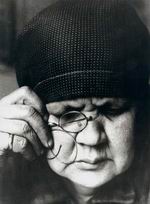
Russian artist, photographer and designer.
He is one of the leaders of the new Soviet art after 1917, but from 1930 on relatively ignored though not wholly unemployed.
He studied art in Kazan (where he met his wife, Varvara Stepanova) and St Petersburg, and in 1915 moved to Moscow to join the avant-garde circles around Malevich and Tatlin.
His abstract paintings show a personal response to the cosmic images of the former; his drawings of 1917-18, ink lines drawn with a ruler and compasses, suggest ‘ratlin’s influence. Rodchenko was to be the most significant of the Constructivists who looked to Tatlin as their leader.
By 1921, he, Stepanova and Alexei Gan had formed the First Working Group of Constructivists within the institute, opposing functional and ideological principles to Kandinsky’s program of investigating the sensory factors operating in the arts; the Group’s analysis led them to assert the need for artists to abandon all special, artistic, activities and to work in the factories to develop a new inventive spirit in design and production.
He made standing and hanging constructions, some of which he showed in a Moscow exhibition of 1921 alongside constructions by the Stenberg brothers, Medunetsky and Karl luganson. The two-part exhibition 5×5 = 25, shown in Moscow later that year included Stepanova, Popova, Vesnin, and Ekster and was intended as an anti-painting manifestation.
Another exhibition of constructions, including Rodchenko’s, was shown in Moscow in January 1922 as the Exhibition of Constructivists. He was among the youngest contributors to the First Russian Art Exhibition in Berlin.
From 1922 on he devoted much of his energies to design of various sorts and to teaching design. He designed titles for Dziga Vertov’s films and photomontage covers for the film magazine edited by Gan, as well as posters and advertisements, in 1923 beginning to collaborate with Mayakovsky who provided snappy, popular texts. His photomontages offer a brilliant visual accompaniment to Mayakovsky’s love poem, About That.
For some years he contributed to, and designed the journal Lef and its successor Now Lef (1923-1925 and 1927-1928). In 1925 he headed the team sent to Paris to see to the Soviet display at the International Exhibition of Decorative Arts. This included samples of his own work and for the Soviet pavilion (designed by Melnikov) he created a Workers’ Club interior which attracted wide notice in a show otherwise devoted almost exclusively to expensive productions for bourgeois tastes.
Back in Russia, Rodchenko developed his practice as a photographer and had his work published in several magazines (though later his colleagues unjustly charged him with imitating too closely new work by photographers in the West). He worked as consultant and designer on films and in the theatre, and in 1929 did designs for Mavakovsky’s play The Bedbug. Mean-while he had been teaching in the new Moscow art workshops, with some difficulty asserting the need for a department devoted to production design in the face of the growing emphasis on Socialist Realistic painting. By 1931 he was under more general attack from reactionary cultural forces. He continued to work, often with Stepanova, on magazines and albums illustrating Russia’s progress through photographs, and in the mid-1930s he began to paint again, figurative subjects at first and then, in and after 1940, abstract pictures too, including some using a drip technique which may have anticipated Pollock’s.
Rodchenko’s faith and energy make him in several respects a Soviet equivalent to the West’s Moholy-Nagy, though circumstances sorely limited his opportunities from the late 1920s on. Compared with Tatlin, he was a practical and hurried operator rather than a thoughtful and poetically creative artist. Books and exhibitions have made his work known outside Russia from the 1970s on. Apart from his important role as animator of new, socially useful activities in the young Soviet state, he is now honored for his pioneering work as photographer.

Tremendous issues here. I am very satisfied to look
your article. Thank you so much and I’m taking a look forward to contact you.
Will you kindly drop me a e-mail?